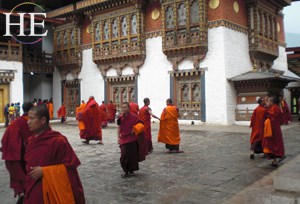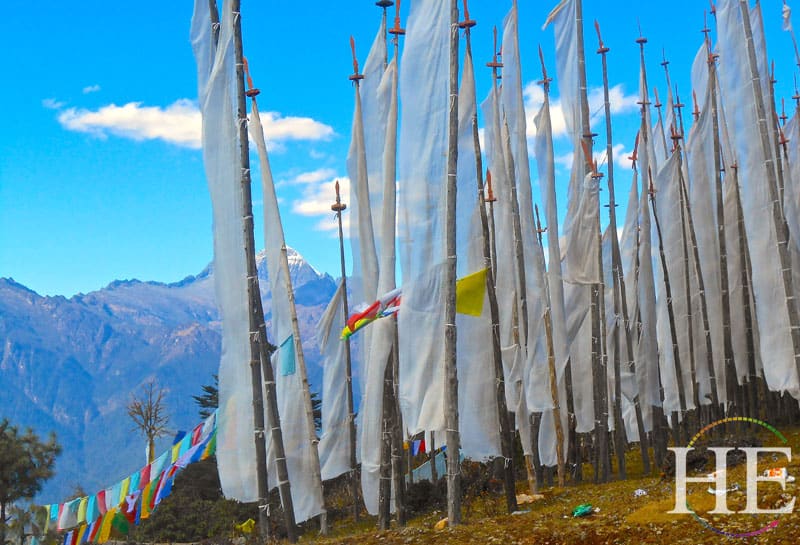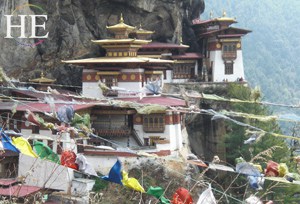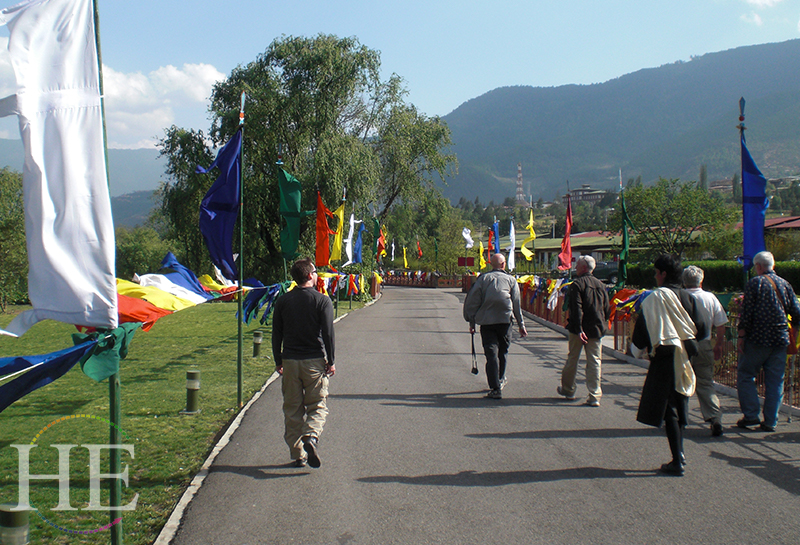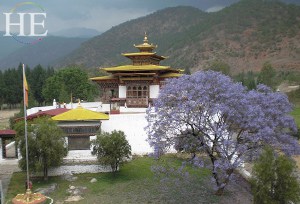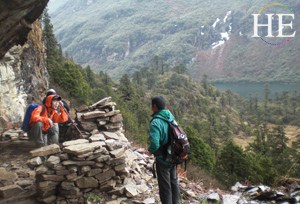Bhutan Trek: A Gay Travel Adventure Tour
A Gay Travel Bhutan Hiking Adventure
Prices listed are per person:
Shared Room: $TBA
Private Room: $TBA
Physical Challenge
We currently do not offer a Bhutan Adventure Tour. In the meantime, how about a hike in Switzerland?
Highlights
Visit Buddhist monasteries in a remote mountain region
Hike on trails nestled beneath the Himalayas
Experience a society mostly uninfluenced by the West
Enjoy an exclusive experience as one of the limited numbers of tourists allowed in Bhutan each year
Overview
With the addition of OutQuest Global Adventures (formerly OutWest) to our HE Travel family of tours, we are pleased to offer two parallel tours to the mysterious Himalayan country of Bhutan, a Trekking Tour and an Overland Tour!
Members of both tours start the adventure together, climbing up to the Tigers Nest Monastery, the most iconic symbol of Bhutan, hugging the side of a mountain cliff. For the middle five days of the tour we will separate into two groups, then reunite in the capital city of Thimphu for the last couple of days to share our tales with each other.
Travelers who thrive on high-adrenaline experiences will enjoy a magnificent trek to see landscapes only accessible on foot and spend four nights at high-altitude camps. Veterans of HE Travel’s Inca Trail tour and OutQuest’s Kilimanjaro Climb will enjoy adding this trek to their personal achievements.
Those who want to indulge in the splendors of Bhutan but don’t want to work quite so hard will stay in hotels for the entire trip. There will be several hikes for our Overland Tour travelers as well, but at lower altitudes, and with overnight stays at simple but comfortable hotels in some of Bhutan’s smaller towns.
Itinerary
Map:
Day 1: Arrival in Bhutan
The scenic flight into Paro offers a spectacular view of the Himalayan ranges. If you’re lucky, you may even see Mount Everest and other famous peaks like Kanchenjunga, Makalu, and Chomolhari. HE Travel will arrange your flight to Paro, Bhutan from Bangkok.
Upon arrival, you’ll be greeted by our local hosts and taken sightseeing in the Paro valley. We start with Ta Dzong, a monastery/fortress that was later converted into the National Museum in 1967. A Dzong is a fortress-like structure that functions as a monastery. Inside the museum, you will find many antique paintings, carvings, statues, textiles, and jewelry. We’ll drive to the Rimpung Dzong which was built in the 17th century. This dzong is now the administrative center and school for the monks. In the afternoon, we’ll check into the hotel.
Day 2: Paro, Drukgyl Dzong, and the hike to Taktsang (The Tiger’s Nest)
Today, we’ll visit the Drukgyel Dzong, a 17th-century monastery ruin. This fortress was built in 1649 by Shabdrung Ngawang Namgyal in a location chosen for its control of the route to Tibet. The Dzong was named Druk (Bhutan) gyel (victory) to commemorate the victory of Bhutan over Tibetan invaders in 1644. On a clear day, one can get a glimpse of Mount Chomolhari, the Mountain of Goddess (24,000ft).
Today’s hike will bring us to the Taktsang (Tiger’s Nest) Monastery on the side of a cliff 900m above the floor of Paro valley. As believed by the Bhutanese, Guru Padmasambhava (a very famous Buddhist saint) flew here on a Tigress’s back in the 8th century and meditated for three months. Guru Padmasambhava was the one who later converted the whole Paro valley into Buddhism.
Day 3: The Start of the Trek: Paro to Jili Dzong
On our Bhutan trek, pack animals carry all of the gear while you just carry a daypack. There will be guides, cooks, and camp staff throughout the trek. You can relax and let the staff take care of the details while you just hike from camp to camp. If you’ve ever done wilderness backpacking, a fully supported trek will seem like a luxury.
You should be prepared to hike 3-6 hours a day with elevation gains of up to 600 vertical meters (about 2000 feet) in a day. The maximum elevation will be 4180 meters (13,700 feet).
We’ll start north of Paro town, up the Du Chhu Valley. Our camp will be close to Jili Dzong, a monastery mostly in ruins. On a clear day, we’ll be able to see Mount Chhomolhari and other snow-capped mountains in the distance. Below is the Paro Valley. 10 km, 3-4 hours, camp at 3450 meters.
Day 4: Jangchu Lakha
We’ll climb through a thick alpine forest and rhododendron to a saddle at 3590 meters. The trail follows the ridges, making ups and downs, staying above the tree line. There are views of Mount Chhomolhari and other snow-capped peaks. You may see yak herders. 11 km, 4-5 hours, camp at 3780 meters.
Day 5: Jimilang Tsho
The trail follows a ridge for about 1 1/2 hours to a saddle at 4040 meters. Then the path drops and follows the ridge back to Jangchu La at 4180 meters. We descend to the camp at 3880 meters. We’ll stay close to the large Jimilang Tsho (Sand Ox Lake), named for a bull that emerged from the lake and joined the cattle of a family that uses the area as a summer grazing ground. The lake is also known for its giant trout. To the west, there are good views of 6989 meter Jichu Drake, the peak representing the protective deity of Paro. 11 km, 4-5 hours, camp at 3880 meters.
Day 6: Simkota Tsho Phajoding
The trail climbs through dwarf rhododendron to the lake of Janye Tsho, another yak herder camp. After a short climb, we’ll descend to camp, close to Simkota Tsho. We’ll pass a small lake then climb to Phume La (4210 meters) where we’ll be greeted by a vast array of prayer flags. Weather permitting there are views of Gangkhar Puensum and other Himalayan peaks. Below sprawls the entire Thimpu valley. The route then descends past Thujidrag Goemba, a precipitous rock face. The descent continues through juniper trees to a campsite beside a community hall near Phajoding Goemba, an important pilgrimage site. 21 km 7-9 hours, camp at 4040 meters.
Day 7: Punaka
It’s all downhill 5 kilometers to the trailhead. The drive to Punakha takes three to four hours and crosses over Dochu La, a mountain pass. At the summit, one gets a panoramic view of the Himalayas. Punakha Dzong is one of Bhutan’s most important historic and religious structures. Construction was started in 1637 and completed the following year. The Dzong is 180 meters long and 72 meters wide and stands six stories tall. For much of Bhutan’s history, Punakha was a center of political, social, and religious life.
That evening will be spent in Wangduephodrang, the site of another impressive fortress. Set atop a hill and above a river, the Dzong was strategically placed in the valley. The evening is spent at a hotel in the area.
Day 8: Visit Punakha Dzong then Thimphu
Punakha Dzong is a magnificent fortress that was the capital of Bhutan until 1955. It was built in 1637 and was named Pungthang Dechen Phodrang (Palace of Great Happiness). In 2011 the royal wedding was held here. Then we’ll travel on to Thimpu, Bhutan’s capital. Perhaps the only world capital without traffic lights, Thimphu keeps many of its traditions rather than adopting modern ways. In this case, they prefer traffic circle cops to the electric lights.
Day 9: Thimphu Sites and Paro
Today the tour includes visits to a variety of types of sites- religious, political, intellectual, and commercial. The Memorial Chorten is a Tibetan-style shrine and a place of devotion for Buddhists. The Handcrafts Emporium is the market where you’ll find locally made crafts and souvenirs. We’ll also visit the mini Zoo to see the national animal, the Takin, which appears to be half goat and half cow. After lunch, we’ll visit a traditional (indigenous) hospital to see how traditional medicines are made. In the late afternoon, we’ll drive down the valley to Paro and our hotel, which is close to the international airport.
Day 10: Departure
From Paro airport, you will fly to Bangkok, Thailand. You may choose to fly to Kathmandu or Delhi, but please check with HE Travel for Druk Air flight options. HE Travel must arrange your flights to and from Bhutan.
Price Includes
Price includes: 5 nights hotel accommodation; 4 nights camping; All camping equipment; Trekking and camp staff; Ground transportation; Sightseeing; Local Bhutanese guide; Entrance fees to sites and museums; Government taxes and fees. Services of a knowledgeable HE Travel tour host (with a minimum number of participants); HE Travel provides complimentary Medical & Evacuation Insurance for every US Resident on our group tours who does not have other coverage.
Not included: Airfare to and from starting and ending points; Personal items including alcoholic beverages, snacks, laundry, and telephone calls; gratuities for guides and HE Travel host.
Tour Insurance
We strongly recommend the purchase of Trip Cancellation and Interruption insurance to protect your vacation investment in case of unforeseen circumstances such as flight delay, illness, or injury. Click Here to learn more about our Insurance partner.
FAQ
We don’t suggest arriving early in Bhutan. If you must because of flights, we can arrange additional nights and accommodations in Paro.
However, we suggest arriving a day or two early in Bangkok. The Bhutan trip begins on Sunday. In most cases, you will have to arrive in Bangkok, Thailand on Saturday. We recommend arriving at least one day early to acclimate to the time change. The airport code is BKK. Please allow HE Travel to arrange your flights between Bangkok and Paro, Bhutan.
Paro is serviced by Druk Air, Bhutan’s national airline. We suggest connecting in Bangkok, Thailand to a Druk Air flight. This will mean staying the night before in Bangkok. We can arrange a hotel for you, or a short getaway in Bangkok, if you have extra time.
You’ll depart on Tuesday. You should not schedule a flight out of Bangkok until after 7:00 pm local time.
This process is much easier than it seems as HE Travel takes care of the visa arrangements.
For your short time in Thailand, For most nationalities including Americans, Australians, and most Europeans, no special visa is required for tourists staying 30 days or less.


